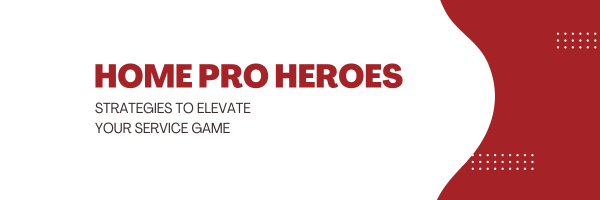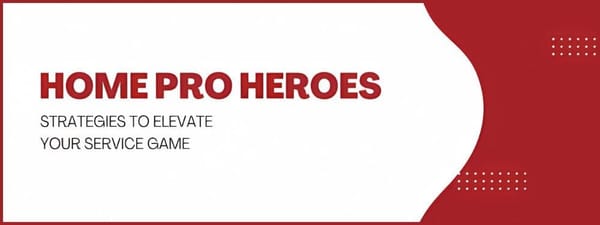Home Pro Heroes 6/10/2024
Home Pro Heroes

Welcome To Home Pro Heros
Trivia Question❓
What is the recommended frequency for servicing and inspecting a home's fire alarm system?
Answer at the bottom of the newsletter
Situational Training and the Communication Skill Gap
By Chris Crew
It happens. All of us at some point have sent a technician into a service call that requires more training than they have. Perhaps it’s because they weren’t technically advanced enough to handle the issue and not communications-savvy enough to save the job? Regardless, when we discover that any one of our techs have skill gaps, the ball now lands in our court. The question is, what do we do about it?
First, let’s look at the role of a tech as they step foot into your client’s home or business.
The tech’s job is to figure out how to resolve the issue. One skill gap may be that they don't have the technical knowledge, which decreases their ability to really fix the “why” of why they were called to the home or business in the first place. If the tech possesses good communication skills, they can convey this to your client without causing concern, even arranging for one of your more advanced techs to resolve it, thus saving you the job. If they lack the “people skills” to finesse the situation, however, you may lose the job (or worse, a customer).
Another scenario may be more common to what we often find in our industry; technicians who are super confident on the technical side but aren’t strong in their “people” skills. When the service call goes well, this skill gap is not as obvious. But keep in mind that means they’ll most likely leave a successful call without a five-star review, a recommendation to a neighbor, or a future maintenance call on the books. It's at that point where we realize that communication skills become nearly as valuable to your business as technical expertise.
The good news is that training can be leveraged to close this skill gap.
Of course, getting your technically gifted technicians to embrace communication training may not be easy. One way is to remind them that in order to be able to showcase to clients how technically competent they are, they must first cross the bridge of being competent in their communication. Another motivating factor is that good communication skills often result in upselling, which increases the numbers for your technician as well as your company.
But first, you must sell the idea to yourself. You need to fully understand how important it is to send a communications-savvy tech into a customer’s home or business. A lot of times we assume that if the technician can just tell the client what needs to be done, they should be able to make the sale. However, that’s not necessarily the case. That’s where situational training comes in.
So, what’s the best way to implement situational training? Once you’ve gathered your techs in the training room you'll want them to start talking different scenarios through. That is the essence of situational training. You can do this as a group, small group exercise, or an individual exercise. I recommend that you sprinkle in a little bit of each.
Situational training. allows the opportunity to get into the mind of the technician, to see what are they writing up to propose to the customer, and any other aspect that has to do with the reason why they were called out.
Here at The Blue Collar Success Group®, we believe in writing up options that allow the client to choose the repair that they need. This is something that I practiced as former owner/manager of a multi-location electrical company. I would conduct situational training this way; l asked them to write me up three solution-based options, allowing me to see what they recommend technically. I then asked them to position it and offer it to me as if I were the client. Keep in mind that these options are three solution-based ways to take care of the reason why the client called us as more of a good, better, best scenario.
Why do we do this? Because It’s super important to extract all the value out of situational training so that you can close the skill gap and drive revenue. This is why we get them to explain the why. Having this gives you the opportunity to train them beyond the technical and allow them to become a more well-rounded team member.
The Blue Collar Success Group® offers various trainings for technicians, each of which is based on The 12 Steps to the Ultimate Client Experience™.
What this does is this not only increase their skill set, both technically and in communication, it also creates a higher level of confidence. And we know that higher confidence creates higher revenue and happier team members. If you are interested in receiving a copy of this free tool, we’d be happy to send it to you at no obligation. Simply click here.
In conclusion, situational training is where we workshop the profile of a service call and review the options provide by the technician. After we have gotten a glimpse into their mindset and capabilities, we can work with them to close those skill gaps.
And the best part? As you're doing this, you're going to see the eyes light up inside of your other technician, as they learn from you and their fellow other members. And that, my friend, will help you close the skill gap and drive revenue through situational training and get on the road to bigger ticket service calls.
Discover the power of company wellness and tax savings at our upcoming on demand training! Register to unlock strategies that promote employee well-being while optimizing tax benefits for your business.
You'll gain invaluable insights from industry experts on implementing wellness programs that boost productivity, reduce healthcare costs, and create a positive work environment. Learn how prioritizing employee wellness not only enhances morale but also contributes to long-term financial savings through tax incentives and deductions.
Whether you're a small business owner, HR professional, or tax advisor, this training is designed to equip you with actionable strategies and best practices for integrating wellness initiatives into your company's culture while maximizing tax savings opportunities.
Don't miss out on this opportunity to revolutionize your approach to employee wellness and tax planning. Register now and take the first step towards a healthier, more tax-efficient business!
Register HERE
💡 Answer to Trivia Question:
Annually, or as recommended by the manufacturer.
See You Wednesday!
The Home Pro Heros Team



